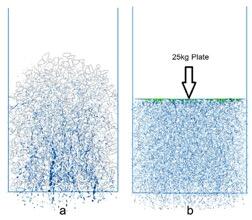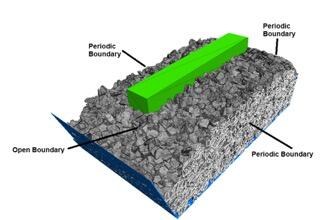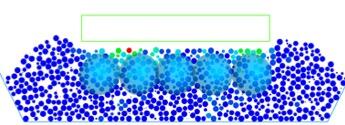Principal Investigator/Researcher
Dr. Mehdi Ahmadian, Virginia Tech
Project Description
The development of Discrete Element Model (DEM) of railway ballast for the purpose of studying the behavior of ballast particles during tamping is addressed in a simulation study. The research aims at optimizing the railroad tamping operation. A comprehensive literature review of applicability of DEM techniques in modeling the behavior of railway ballast has been conducted. The feasibility of DEM methods in studying the fundamental mechanisms that dictate the outcome of railroad tamping process has been analyzed. Using a DEM-based commercial software, a simulation model of the dynamics of railway ballasts during tamping has been developed and validated. The selection and calibration of ballast parameters, such as inter-particle contact force laws, ballast material properties, and selection of particle shape in the model have been evaluated in detail. Finally, a complete tamping simulation model has been constructed with high degree of adjustability to allow control of all process parameters for achieving realistic output.
An analysis of the modeling results shows that DEM is a highly valuable tool for studying railroad tamping operation. It has the capability to provide crucial and unprecedented insights into the process, facilitating not only the optimization of current tamping practices, but also the development of novel methods for achieving sustainable improvements in track stability after tamping in the future.
Different ways of modeling particle shapes have been evaluated and it has been shown that while using spheres to represent irregular ballast particles in DEM provides large gains in computational efficiency, they cannot capture all properties of irregularly-shaped particles. Additionally, the results indicate that the model is able to accurately predict properties of granular assemblies of the railway ballast in different test cases. The half-track model that has been developed thus far can be extended in future studies for evaluating rail track settlement and stability, optimization of tamping process, and performance of different ballast gradations.
Implementation of Research Outcomes
This simulation modeling is on-going. Any implementation on railroad tampers by equipment manufacturers or the tamping practices by the U.S. railroads will involve interactions and discussions that have fallen beyond the scope of the effort thus far. We intend to conduct such discussions in the future.

Illustration of the vibrating axis of the tamping tine (left) and penetration of ballast by the tine (right)

Distribution of contact forces for spherical particles within (a) the naturally settled ballast, and (b) fully compacted ballast

Distribution of contact forces for irregular particles (clumps) within (a) the naturally settled ballast, and (b) fully compacted ballast

Location and types of boundary conditions for the ballast. Reduction in number of modeled particles by the introduction of periodic boundary conditions is emphasized

Configuration of measuring spheres below the sleeper for recording output data during simulations
Impacts/Benefits of Implementation
Tamping is a critical effort for stabilizing the track. It has a major impact on the maintenance of the way. Yet, not many studies have evaluated the dynamics that occurs during tamping. Such studies can have a significant impact on improving tamping practices beyond the mostly anecdotal knowledge that is currently available, resulting in large cost savings and improved rail safety.
Web Links
Final Report
Outputs:
1 conference paper, 1 thesis
• Nilesh Dama, Mehdi Ahmadian, Discrete element modeling of railway ballast for studying railroad tamping operation, ASME/IEEE Joint Rail Conference, Volume 83587, Pages V001T08A003, 2020
• Nilesh M. Dama, Discrete Element Modeling of Railway Ballast for Studying Railroad Tamping Operation, Thesis in Mechanical Engineering at Virginia Tech, 2019